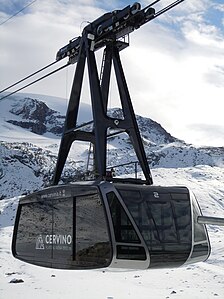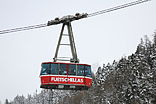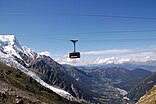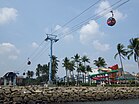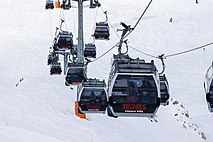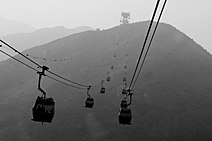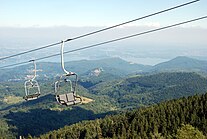Aerial lift
This articleneeds additional citations forverification.(December 2020) |
Anaerial lift,[1]also known as acable carorropeway,is a means ofcable transportin whichcabins,cars,gondolas,oropen chairsare hauled above the ground by means of one or morecables.Aerial lift systems are frequently employed in a mountainous territory where roads are relatively difficult to build and use, and have seen extensive use in mining. Aerial lift systems are relatively easy to move and have been used to cross rivers and ravines. In more recent times, the cost-effectiveness and flexibility of aerial lifts have seen an increase ofgondola liftbeing integrated into urban public transport systems.[citation needed]
Types
[edit]Cable Car
[edit]Acable car(British English) or anaerial tramway,aerial tram(American English), uses one or two stationary ropes for support while a separate moving rope provides propulsion.[2]The grip of an aerial tramway is permanently fixed onto the propulsion rope. Aerial trams used for urban transport include theRoosevelt Island TramwayinNew York City,as well as thePortland Aerial Tram.[citation needed]
Gondola lift
[edit]Agondola liftconsists of a continuously circulating cable that is strung between two or more stations, over intermediate supporting towers. The cable is driven by abullwheelin a terminal, which is connected to anengineorelectric motor.[3]Multiple gondola cabins are attached to the cable, usually with detachable grips, enabling them to slow down in the stations to facilitate safe boarding. Fixed grip variants exist, although these are considerably less common. Lifts with a single cable are sometimes referred to as "mono-cable" gondola lifts. Depending on the design of the individual lift, the capacity, cost, and functionality of a gondola lift will differ dramatically. Because of the proliferation of such systems in theAlpineregions ofEurope,theFrench languagename oftélécabineis also used in anEnglish languagecontext. Gondola lifts are also used for urban transportation. Examples include theSingapore Cable Car,Metrocable (Medellín),Metrocable (Caracas),Mi Teleférico(La Paz), andLondon Cable Car.[citation needed]
Bicable and tricable gondola lifts
[edit]Gondola lifts which feature one stationary 'support' rope and one haul rope are known as bi-cable gondola lifts, while lifts that feature two support ropes and one haul rope are known as tri-cable gondola lifts. Examples includeNgong Ping Skyrail(Hong Kong) and thePeak 2 Peak Gondola(Canada).[citation needed]
Funitel
[edit]
Afuniteldiffers from a standardgondola liftthrough the use of two overhead arms, attached to two parallel haul cables, providing more stability in high winds.[4]The namefunitelis a blend of the French wordsfuniculaireandtelepherique.Systems may sometimes be referred to as "double monocable" (DMC), where two separate haul cables are used, or "double loop monocable" (DLM) where a single haul cable is looped round twice.[citation needed]
Funitels combine a short time between successive cabins with a high capacity (20 to 30 people)[5]per cabin.
Funifor
[edit]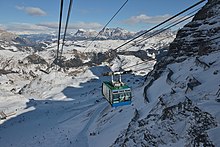

Afuniforis a type of cable car with two support ropes and a haul rope, looped around. Each system is composed of a single cabin shuttling back-and-forth. Many installations are built with two parallel, but independent, lines. The funifor design was developed by the Italian manufacturer, Hölzl, which later merged with Doppelmayr Italia. Today, the design is therefore patented byDoppelmayr Garaventa Group.[6]
At the top of each track, the haul rope loops back to the bottom instead of looping over to serve the other track, as would occur with a normalaerial tramway.This is shown in the diagram below. This feature allows for a single cabin operation when traffic warrants. The independent drive also allows for evacuations to occur by means of a bridge connection between the adjacent cabins. [7] The main advantage of the funifor system is its stability in high wind conditions owing to the horizontal distance between the two support ropes.[6]

Chairlift
[edit]Chairlifts are continuously circulating systems carrying chairs, which usually enable skiers to board without removing skis. They are a common type of lift at mostski areasand in mountainous areas. They can also be found at someamusement parksand tourist attractions.[8]
Detachable chairlifts usually move far faster than fixed-grip chairlifts, typically 5 m/s (16.4 ft/s) compared with 2 to 2.5 m/s (6.6 to 8.2 ft/s). Because the cable moves faster than most passengers could safely disembark and load, each chair is connected to the cable by a powerful spring-loadedcable gripwhich detaches at terminals, allowing the chair to slow considerably for convenient loading and unloading at a typical speed of 0.75 m/s (2.5 ft/s), a speed slower even than fixed-grip. Chairs may be fitted with a "bubble" canopy to offer weather protection.[citation needed]
Hybrid lift
[edit]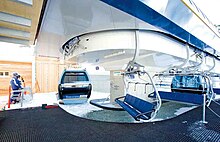
Ahybrid liftis a fusion of a gondola lift and a chair lift. The companyLeitnerrefers to it astelemix,[9]whileDoppelmayruses the termcombination lift.[10]An example isSki Arlberg'sWeibermahdlift inVorarlberg(Austria) which alternates between 8-person chairlifts and 10-person gondolas.[11]
Hand-powered
[edit]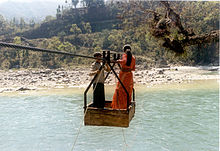
In undeveloped areas with rough terrain, simple hand-powered cable-cars may be used for crossing rivers, such as thetuinused in Nepal.[12][13]
Material ropeways
[edit]
Amaterial ropewayorropeway conveyor[14]is an aerial lift from which containers for goods rather than passenger cars are suspended. These are usuallymonocableorbicable gondola lifts.
Material ropeways are typically found around largeminingconcerns, and can be of considerable length. TheCOMILOG Cableway,which ran fromMoandainGabontoMbindain theRepublic of the Congo,was over 75 km in length. TheNorsjö aerial tramwayinSwedenhad a length of 96 kilometers.[citation needed]
Abbreviations
[edit]The following abbreviations are frequently used in the industry:[citation needed]
| en | English | fr | French | de | German |
|---|---|---|---|---|---|
| ATW | Aerial Tramway | TPH | Téléphérique | PB | Pendelbahn |
| MGD | Monocable gondola detachable | TCD | Télécabine débrayable | EUB | Einseilumlaufbahn |
| BGD | Bicable gondola detachable | TPH 2S | Téléphérique 2S | ZUB | Zweiseilumlaufbahn |
| TGD | Tricable gondola detachable | TPH 3S | Téléphérique 3S | 3S | 3S-Bahn |
| MGFP | Monocable gondola fixed grip pulsed | TCP | Télécabine pulsée | GUB | Einseil-Gruppenumlaufbahn |
| MGFJ | Monocable gondola fixed grip jigback | TCV | Télécabine à va-et-vient | GPB | Einseil-Gruppenpendelbahn |
| BGFP | Bicable gondola fixed grip pulsed | TPH P | Téléphérique pulsé | Zweiseil-Gruppenumlaufbahn | |
| CLF | Chairlift fixed grip | TSF | Télésiège à pince fixe | SB | Sesselbahn fix geklemmt |
| CLD | Chairlift detachable | TSD | Télésiège débrayable | KSB | kuppelbare Sesselbahn |
| CGD | Chairlift gondola detachable | TSCD or TMX |
Téléporté débrayable avec sièges et cabines or Télémix |
Kombibahn (Sessel + Gondel) | |
| FT | Funitel | FUN | Funitel | Funitel | |
| FUF | Funifor | FUF | Funifor | Funifor | |
| RPC | Rope conveyor | Télécorde | Materialseilbahn |
See also
[edit]- Blondin (quarry equipment)
- Cable car (railway)
- Funicular
- List of aerial lift manufacturers
- Space elevator
- Surface lift,another transportation technology
References
[edit]- ^"Skilifts.org - Glossary of Aerial Lift Terms".Skilifts.org.Retrieved26 June2022.
- ^The Gondola ProjectArchived2017-05-17 at theWayback MachineAerial Technologies, Lesson 5: Aerial Trams - Retrieved on 2010-04-24
- ^Cable Propelled Systems in Urban EnvironmentsArchived2012-03-14 at theWayback MachineEdward S. Neumann - Retrieved on 2010-08-05
- ^"funitel « The Gondola Project".Gondolaproject.com.28 October 2011.Retrieved2019-04-22.
- ^"Lift-World:: Lift-Database - Funitels".Archived fromthe originalon 10 February 2012.Retrieved26 June2022.
- ^ab"Funifor".Doppelmayr Garaventa Group.Retrieved2010-12-10.
- ^"Doppelmayr: A convenient trip to the Portavescovo with the Funifor".ropeways.net (SEC - Software Engineering Center, Wanker & Viehauser OEG). 2006-08-11. Archived fromthe originalon 2007-09-28.Retrieved2007-01-13.
- ^"Scenic Skyway - Knoebels, PA".
- ^"Telemix - Products - LEITNER ropeways".Leitner-ropeways.com(in German).Retrieved2019-08-14.
- ^"Combination Lift | Products".Doppelmayr.com.Retrieved2019-08-14.
- ^"8/10-CGD Weibermahd".Doppelmayr.com.
- ^"Tuin river crossings".Practical Action.Archived fromthe originalon 2019-04-11.Retrieved2012-06-09.
- ^"Aerial Ropeways in Nepal".Appropedia.Retrieved2012-06-09.
- ^Ernst, Dr.-Ing. Richard (1989).Wörterbuch der Industriellen Technik(5th ed.). Wiesbaden: Oscar Brandstetter, 1989, p. 659.ISBN3-87097-145-2.

